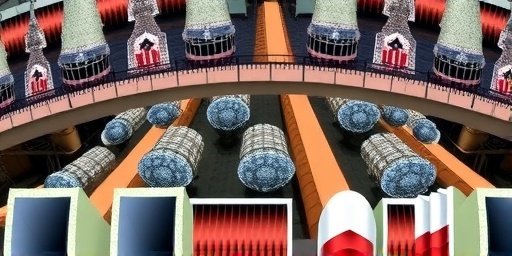In a bold move to reclaim control over vital resources, the U.S. government has unleashed a torrent of financial support for domestic Rare earths production, injecting hundreds of millions in loans, grants, and equity investments. This surge in U.S. investment aims to dismantle China’s overwhelming dominance in the global supply chain for these critical minerals, which power everything from electric vehicles to fighter jets. Officials announced the initiatives on Tuesday, highlighting a strategic pivot amid escalating geopolitical tensions.
- Government Unveils Multi-Million Dollar Funding Wave for Rare Earths Pioneers
- China’s Stranglehold on Rare Earths Sparks U.S. Supply Chain Overhaul
- Boosting Domestic Production: Key Projects and Technological Breakthroughs
- Implications for Tech, Defense, and Global Trade Dynamics
- Charting the Path Forward: Policy Roadmap and International Collaboration
The funding package, totaling over $450 million, targets key players in mining, processing, and refining Rare earths—elements like neodymium, dysprosium, and praseodymium that are indispensable for high-tech industries. With China controlling approximately 85% of the world’s Rare earths processing capacity, the U.S. has long been vulnerable to supply disruptions, as seen in past export restrictions that rattled markets. This new commitment signals Washington’s determination to build a resilient domestic ecosystem, reducing reliance on adversarial supply chains.
Government Unveils Multi-Million Dollar Funding Wave for Rare Earths Pioneers
The U.S. Department of Defense and Department of Energy led the charge, disbursing initial funds through the Defense Production Act and the Bipartisan Infrastructure Law. A standout recipient is MP Materials, the operator of the Mountain Pass mine in California—the only active rare earths mining site in the U.S. The company secured a $250 million loan to expand its processing facilities, aiming to achieve full domestic separation and refining by 2025. “This investment isn’t just about mining rocks; it’s about securing our technological edge,” said MP Materials CEO James Litinsky in a statement.
Other beneficiaries include Lynas Rare Earths, an Australian firm with U.S. operations, which received $120 million in equity stakes to build a heavy rare earths separation plant in Texas. Meanwhile, startups like ReElement Technologies garnered $80 million for innovative recycling methods that could recover rare earths from electronic waste, addressing the growing e-scrap challenge. These targeted U.S. investments reflect a multifaceted approach: from upstream extraction to downstream applications, ensuring a closed-loop supply chain.
Statistics underscore the urgency. The U.S. Geological Survey reports that global demand for rare earths is projected to quadruple by 2040, driven by the clean energy transition. Yet, domestic production currently meets less than 15% of U.S. needs, leaving the nation exposed. By funneling federal dollars into these projects, policymakers are betting on innovation to bridge the gap. Energy Secretary Jennifer Granholm emphasized, “Critical minerals like rare earths are the backbone of our defense and economy. We’re not waiting for supply chain shocks—we’re building ahead of them.”
China’s Stranglehold on Rare Earths Sparks U.S. Supply Chain Overhaul
China’s grip on the rare earths market has been a thorn in the side of Western economies for decades. Since the 1990s, Beijing has methodically consolidated control, leveraging low-cost production and state subsidies to corner the supply chain. In 2010, China briefly halted exports to Japan over a territorial dispute, causing prices to skyrocket by 500% and exposing vulnerabilities worldwide. Today, it processes 90% of global rare earth oxides, forcing even non-Chinese miners to ship concentrates there for refinement.
This dominance extends to critical minerals essential for U.S. national security. Rare earths are key components in F-35 stealth fighters, precision-guided munitions, and radar systems. The Pentagon estimates that a single missile requires up to 920 pounds of these materials. With tensions rising in the South China Sea and over Taiwan, diversifying away from China is no longer optional—it’s imperative. The Biden administration’s strategy builds on prior efforts, like the 2021 executive order on supply chain resilience, but escalates with direct financial firepower.
Industry analysts point to recent events as catalysts. In late 2023, China imposed export controls on gallium and germanium—fellow critical minerals—prompting a 20% dip in U.S. semiconductor stocks. “The U.S. investment in rare earths is a direct response to these tactics,” noted Adamas Intelligence senior analyst Ryan Corbett. “Without it, our supply chain remains a house of cards.” The initiatives also align with broader efforts, such as the Minerals Security Partnership, a multinational alliance to secure ethical sourcing of critical minerals outside China.
To illustrate the scale, consider the economics: Rare earths prices have fluctuated wildly, with neodymium oxide hitting $100 per kilogram in 2022 before stabilizing. U.S. investments aim to stabilize costs through scale, potentially lowering prices by 30% for domestic buyers within five years, according to a report from the Breakthrough Institute.
Boosting Domestic Production: Key Projects and Technological Breakthroughs
At the heart of this U.S. investment push are ambitious projects designed to revive American rare earths capabilities. Beyond MP Materials, the Texas Mineral Resources Corp. is developing the Round Top project in West Texas, backed by a $50 million grant for exploratory drilling. This deposit holds over 1.5 billion tons of rare earth-bearing ore, enough to supply U.S. demands for centuries if fully operational.
Technological innovation is another pillar. The Department of Energy awarded $30 million to universities and labs for advanced extraction techniques, including bioleaching—using microbes to separate rare earths more efficiently and environmentally. Traditional mining methods are energy-intensive and polluting, but these breakthroughs could cut water usage by 70% and reduce carbon emissions, making U.S. production competitive globally.
Processing remains the bottleneck. Currently, the U.S. ships most raw ore to China for refinement due to a lack of facilities. The new investments fund magnet manufacturing hubs, vital for electric motors in EVs and wind turbines. For instance, General Motors, in partnership with a DOE-backed consortium, is investing $35 million in a rare earth-free magnet alternative, but parallel efforts ensure supply for legacy tech.
Quotes from stakeholders highlight momentum. “These funds will accelerate our timeline from years to months,” said Lynas CEO Amanda Lacaze. Environmental groups, often wary of mining, have cautiously endorsed the push if paired with sustainable practices. The Sierra Club noted, “Responsible U.S. investment in critical minerals can green our supply chain without repeating past ecological mistakes.”
Looking at employment impacts, these projects could create 10,000 high-wage jobs in rural areas, from Nevada to Texas, revitalizing communities hit by manufacturing declines. A study by the American Geosciences Institute projects a $20 billion economic ripple by 2030.
Implications for Tech, Defense, and Global Trade Dynamics
The ripple effects of this U.S. investment extend far beyond mining sites, reshaping industries reliant on rare earths. In the tech sector, companies like Apple and Tesla, which use these minerals in batteries and screens, stand to benefit from stabilized supplies. Disruptions could add $1 trillion to global EV costs by 2030, per BloombergNEF estimates. By fortifying the supply chain, the U.S. aims to keep innovation humming without price volatility.
Defense implications are even starker. The U.S. military consumes 10% of global rare earths, and shortages could hobble readiness. Recent wargames simulated China cutting off supplies, revealing gaps in stockpiles that last only months. These investments, including a $100 million stockpile expansion, mitigate such risks, ensuring munitions production continuity.
On the trade front, the moves challenge China’s monopoly, potentially sparking a new era of competition. Allies like Australia and Canada are syncing efforts; Australia’s Iluka Resources just opened a rare earths refinery with U.S. tech support. However, challenges persist: Building expertise takes time, and China could undercut prices to maintain leverage.
Experts foresee a tipping point. “By 2027, non-Chinese processing could reach 20% of global capacity, thanks to U.S. investment,” predicts the International Energy Agency. This shift promotes fairer trade, reducing coercion risks and fostering alliances.
Charting the Path Forward: Policy Roadmap and International Collaboration
As these initiatives roll out, the U.S. is outlining a clear roadmap to sustain momentum. The National Defense Authorization Act for 2024 includes provisions for annual audits of critical minerals supply chains, with penalties for over-reliance on China. Additional U.S. investment is earmarked for workforce training—$20 million for STEM programs in mining engineering—to build a skilled labor pool.
International collaboration is key. The U.S. is deepening ties with the European Union through the Critical Raw Materials Act, sharing R&D on rare earths recycling. Japan, burned by the 2010 embargo, is co-funding U.S. projects to the tune of $50 million. These partnerships aim for a diversified supply chain spanning the Indo-Pacific.
Looking ahead, success hinges on execution. If projects hit milestones, the U.S. could export refined rare earths by 2026, flipping the script on China. Policymakers warn of hurdles like permitting delays and market fluctuations, but optimism prevails. “This is our moonshot for minerals,” quipped a White House official. Ultimately, these efforts promise a more secure, self-reliant America, insulating critical minerals flows from geopolitical storms and powering the next industrial revolution.









